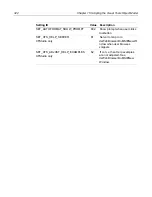
326
Glossary
localhost
Host name for the computer that you are currently using.
mailto
Tag that creates an e-mail link. This link opens the user’s e-mail program, if he has
one, and begins a new message to the e-mail address contained in the <
mailto>
tag.
mapping
Association between the physical directories where your files are stored and the
server that processes the files.
markup language
Language that structures information for display purposes, like HTML, or for data
storage and retrieval, like XML. All markup languages are a subset of the Standard
General Markup Language (SGML).
palette
Group of colors that you can use in developing your Web site. A “browser-safe”
palette only has colors that are rendered the same across browsers.
path
Route that a computer takes to access or upload a file. Paths can be
absolute
or
relative
. An absolute path leads to a single possible location for the file to be accessed
or uploaded; for example, C:\Program Files\Macromedia\H for
Dreamweaver MX\UserData. A relative path leads to the file based on the location of
something else; for example, code snippets are written to \UserData, on whatever
drive and directory that you installed H for Dreamweaver MX. Other
examples of paths: URLs, such as http://www.macromedia.com; IP addresses, such
as 132.96.219.3; and
localhost
to signify the computer that you are currently using.
PNG
Portable Network Graphics. Type of image file (.png) that has a small file size but less
detail than the JPG file. PNG files are perfect for images that need to download
quickly onto a user’s computer. They are smaller in file size and of higher quality than
GIF files, but unlike GIFs they do not support animation.
project
In H for Dreamweaver MX, a project organizes the files in a Web site
or Web
application
by grouping them in a central location. (This location can be physical or
virtual.) Using projects simplifies deployment and maintenance tasks such as link
verification and extended search and replace.
RDS
Remote Development Services. Proprietary protocol that is built into HomeSite MX
for Dreamweaver. RDS does everything that FTP does, and also lets developers
browse server databases, debug remote applications, and use server-side source
control. The RDS server also manages security. The RDS server is always the
ColdFusion Server.
Summary of Contents for HOMESITE
Page 11: ...Contents xi Table of CommandID values 310 Table of SettingID values 314 Glossary 323...
Page 12: ...xii Contents...
Page 20: ...xx About This Book...
Page 28: ...8 Chapter 1 Setting Up the Product...
Page 70: ...50 Chapter 4 Managing Files...
Page 88: ...68 Chapter 5 Writing Code and Web Content...
Page 116: ...96 Chapter 6 Editing Pages...
Page 148: ...128 Chapter 7 Using Web Development Languages...
Page 190: ...170 Chapter 11 Deploying Files...
Page 210: ...190 Chapter 12 Testing and Maintaining Web Pages...
Page 216: ...196 Chapter 13 Extending the Help System...
Page 350: ...330 Glossary...
Page 358: ...338 Index...













































